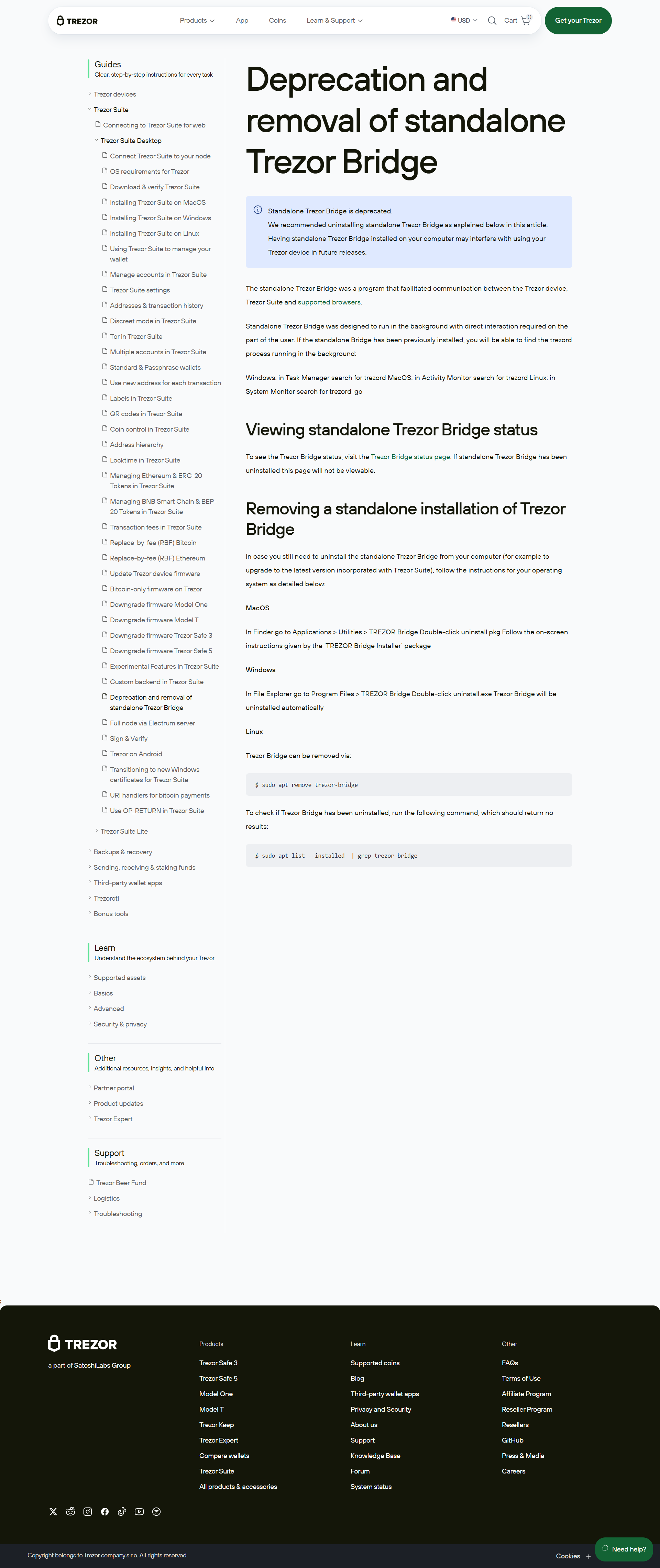Trezor Bridge: A Deep Dive Into the Connectivity Engine Powering Your Crypto Hardware Wallet
Introduction
In an age of ever-increasing cyber threats, securing your crypto assets isn’t just an option—it’s a necessity. While hardware wallets like the Trezor Model One and Trezor Model T are built to offer robust security, seamless interaction between your wallet and your computer wouldn’t be possible without one key software layer: Trezor Bridge.
This powerful utility quietly but critically facilitates encrypted communication between your computer and Trezor device, forming the foundation of secure operations across platforms. Whether you're performing a firmware update, transferring tokens, or accessing DeFi applications through your browser, Trezor Bridge ensures that communication between software and hardware remains tamper-proof.
What Is Trezor Bridge?
Trezor Bridge is a local communication protocol created by SatoshiLabs, the creators of the Trezor hardware wallet. Unlike most software applications, Trezor Bridge doesn’t have a GUI (graphical user interface). Instead, it runs in the background as a local service that allows web applications or Trezor Suite to interface securely with your hardware wallet.
Trezor Bridge: Purpose and Importance
At its core, Trezor Bridge is designed to:
- Enable USB communication between your Trezor wallet and your operating system
- Replace older, less secure browser-based extensions
- Offer consistent support across Windows, macOS, and Linux
- Secure data transmission via local encryption protocols
In SEO terms, it addresses long-tail keyword queries such as:
- “How to connect Trezor to PC”
- “Trezor wallet not detected on browser”
- “Trezor Bridge download for Mac/Linux/Windows”
Why Trezor Bridge Matters in the Crypto Ecosystem
Cryptocurrency wallets have evolved rapidly, with increasing demands for speed, accessibility, and multi-platform compatibility. Users now expect their hardware wallets to interface with decentralized exchanges, NFT marketplaces, DeFi protocols, and more.
Trezor Bridge plays a vital role in bridging this expectation with reality.
Real-World Use Case
Imagine a user wants to swap ETH for USDC using a DEX like Uniswap via MetaMask. With Trezor connected as a signing device, MetaMask relies on Trezor Bridge to pass transaction data securely to the Trezor wallet. The transaction is signed on the hardware wallet, which never exposes the private key to the browser or PC. The result? A secure, user-approved transaction—powered by Bridge.
How Trezor Bridge Works Behind the Scenes
Trezor Bridge operates as a local service that listens for commands from Trezor Suite (or supported web apps) and forwards them to the Trezor device over USB.
Workflow:
- User Action: You initiate a transaction or action on Trezor Suite or a third-party wallet.
- Bridge Request: The application sends a JSON-formatted request to Trezor Bridge.
- USB Communication: Bridge translates this into commands understood by your Trezor device.
- Device Signature: The device signs the transaction or processes the command.
- Response: Bridge sends the signed data back to the application.
This real-time communication ensures security while enabling smooth operation for both basic users and power users.
Installation Guide: How to Install Trezor Bridge on Any OS
Trezor Bridge is easy to install and supports the most widely used operating systems.
1. Windows Installation
- Visit the official Trezor website: https://trezor.io/bridge
- Download the
.exeinstaller - Follow the prompts
- Restart your browser after installation
2. macOS Installation
- Download the
.pkgfile for macOS from the same link - Run the installer
- If prompted, authorize in System Settings → Security & Privacy
- Restart your browser and plug in the Trezor device
3. Linux Installation
- Download the appropriate
.debor.rpmpackage - Use
dpkg -iorrpm -ito install it via terminal - Confirm that
trezordservice is running
✅ SEO Tip: Pages including phrases like "How to install Trezor Bridge on Ubuntu" or "macOS Trezor Bridge guide" often rank higher due to exact-match query targeting.
Updating and Maintaining Trezor Bridge
Regular updates are vital to maintaining security and compatibility with firmware changes and browser policies.
- Check regularly at https://trezor.io/bridge
- Updates are usually automatic if using Trezor Suite
- Manual reinstallations are simple and typically retain all previous settings
Key Features and Benefits of Trezor Bridge
✅ Full Encryption and Local Security
Unlike browser-based communication, Trezor Bridge processes data locally—never sending transaction data over the cloud or internet.
✅ Cross-Browser Support
Bridge enables compatibility with:
- Chrome
- Firefox
- Brave
- Edge (via Trezor Suite Web)
WebUSB doesn’t work consistently across all browsers. Trezor Bridge fills the gap with guaranteed functionality.
✅ Compatible with Third-Party Tools
Applications like MetaMask, Electrum, Exodus (via Trezor Connect), and others often depend on Trezor Bridge for USB-based wallet signing functionality.
✅ Open Source and Transparent
Trezor Bridge is hosted on GitHub and is fully open-source. Developers can audit, modify, or fork it according to custom needs.
Common Issues and Troubleshooting Trezor Bridge
Problem: Trezor not recognized
- Ensure Bridge is installed and running
- Restart browser
- Reconnect device and verify firmware
Problem: Browser extension conflicts
- Uninstall legacy Chrome extensions for Trezor
- Ensure no WebUSB conflicts exist
Problem: Multiple users on one machine
- Bridge works per-user session; avoid running it under multiple system profiles simultaneously
Frequently Asked Questions (FAQs)
Q1. Can I use Trezor without Bridge? A: Some browsers offer WebUSB support, but it’s limited. Bridge offers better stability and broader support.
Q2. Is Trezor Bridge safe to use? A: Yes. It is open-source, maintained by Trezor’s developers, and reviewed frequently for security vulnerabilities.
Q3. Is Trezor Bridge required for the Trezor Suite Desktop App? A: No. The desktop version of Trezor Suite includes native USB support. Bridge is primarily needed for browser-based Suite access and third-party integrations.
Q4. How do I uninstall Trezor Bridge?
A: Use your system's application manager to remove the software. On Linux, use your package manager (apt remove, yum erase, etc.).
